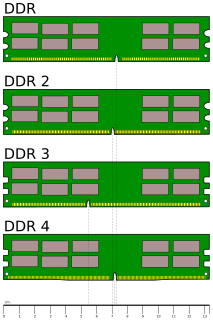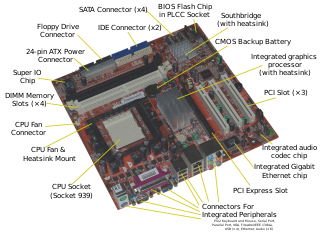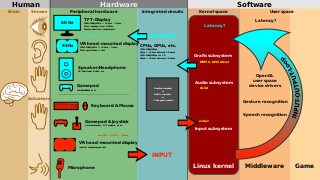
Double Data Rate Synchronous Dynamic Random-Access Memory, officially abbreviated as DDR SDRAM, is a double data rate synchronous dynamic random-access memory class of memory integrated circuits used in computers. DDR SDRAM, also retroactively called DDR1 SDRAM, has been superseded by DDR2 SDRAM, DDR3 SDRAM and DDR4 SDRAM. None of its successors are forward or backward compatible with DDR1 SDRAM, meaning DDR2, DDR3, and DDR4 memory modules will not work in DDR1-equipped motherboards, and vice versa.

A motherboard is the main printed circuit board (PCB) found in general purpose computers and other expandable systems. It holds and allows communication between many of the crucial electronic components of a system, such as the central processing unit (CPU) and memory, and provides connectors for other peripherals. Unlike a backplane, a motherboard usually contains significant sub-systems such as the central processor, the chipset's input/output and memory controllers, interface connectors, and other components integrated for general purpose use and applications.

Static random-access memory is a type of semiconductor memory that uses bistable latching circuitry (flip-flop) to store each bit. SRAM exhibits data remanence, but it is still volatile in the conventional sense that data is eventually lost when the memory is not powered.

Dynamic random-access memory (DRAM) is a type of random access semiconductor memory that stores each bit of data in a separate tiny capacitor within an integrated circuit. The capacitor can either be charged or discharged; these two states are taken to represent the two values of a bit, conventionally called 0 and 1. The electric charge on the capacitors slowly leaks off, so without intervention the data on the chip would soon be lost. To prevent this, DRAM requires an external memory refresh circuit which periodically rewrites the data in the capacitors, restoring them to their original charge. This refresh process is the defining characteristic of dynamic random-access memory, in contrast to static random-access memory (SRAM) which does not require data to be refreshed. Unlike flash memory, DRAM is volatile memory, since it loses its data quickly when power is removed. However, DRAM does exhibit limited data remanence.

A DIMM or dual in-line memory module comprises a series of dynamic random-access memory integrated circuits. These modules are mounted on a printed circuit board and designed for use in personal computers, workstations and servers. DIMMs began to replace SIMMs as the predominant type of memory module as Intel P5-based Pentium processors began to gain market share.

Double Data Rate 2 Synchronous Dynamic Random-Access Memory, officially abbreviated as DDR2 SDRAM, is a double data rate synchronous dynamic random-access memory interface. It superseded the original DDR SDRAM specification, and is superseded by DDR3 SDRAM. DDR2 DIMMs are neither forward compatible with DDR3 nor backward compatible with DDR.

A northbridge or host bridge is one of the two chips in the core logic chipset architecture on a PC motherboard, the other being the southbridge. Unlike the southbridge, northbridge is connected directly to the CPU via the front-side bus (FSB) and is thus responsible for tasks that require the highest performance. The northbridge is usually paired with a southbridge, also known as I/O controller hub. In systems where they are included, these two chips manage communications between the CPU and other parts of the motherboard, and constitute the core logic chipset of the PC motherboard.

A SO-DIMM, SODIMM, or small outline dual in-line memory module, is a type of computer memory built using integrated circuits. SO-DIMMs are a smaller alternative to a DIMM, being roughly half the size of regular DIMMs.
Rambus Incorporated, founded in 1990, is an American technology company that designs, develops and licenses chip interface technologies and architectures that are used in digital electronics products. The company is well known for inventing RDRAM and for its intellectual property-based litigation following the introduction of DDR-SDRAM memory.
Semiconductor memory is a digital electronic data storage device, often used as computer memory, implemented with semiconductor electronic devices on an integrated circuit (IC). There are many different types of implementations using various technologies.
A general-purpose input/output (GPIO) is an uncommitted digital signal pin on an integrated circuit or electronic circuit board whose behavior—including whether it acts as input or output—is controllable by the user at run time.
In computing and especially in computer hardware, a controller is a chip, an expansion card, or a stand-alone device that interfaces with a peripheral device. This may be a link between two parts of a computer or a controller on an external device that manages the operation of that device.

MoSys, Inc. is a publicly traded fabless semiconductor company based in Santa Clara, California that sells solutions for data path connectivity, speed and intelligence while eliminating data access bottlenecks on line cards and systems scaling from 100G to multi-terabits per second. Prior to 2012 it also sold high-performance embedded DRAM under IP cores under the "1T-SRAM" moniker as well high-speed SerDes cores and DDR interface IP. Customers for MoSys IP included a wide range of IDMs, foundries, and other fabless semiconductor companies. Applications included networking, consumer products, graphics systems, general computing, and storage systems.

An open collector is a common type of output found on many integrated circuits (IC), which behaves like a switch that is either connected to ground or disconnected.
The memory controller is a digital circuit that manages the flow of data going to and from the computer's main memory. A memory controller can be a separate chip or integrated into another chip, such as being placed on the same die or as an integral part of a microprocessor; in the latter case, it is usually called an integrated memory controller (IMC). A memory controller is sometimes also called a memory chip controller (MCC) or a memory controller unit (MCU).

In computing, a memory module is a printed circuit board on which memory integrated circuits are mounted. Memory modules permit easy installation and replacement in electronic systems, especially computers such as personal computers, workstations, and servers. The first memory modules were proprietary designs that were specific to a model of computer from a specific manufacturer. Later, memory modules were standardized by organizations such as JEDEC and could be used in any system designed to use them.
Tolapai is the code name of Intel's embedded system-on-a-chip (SoC) which combines a Pentium M (Dothan) processor core, DDR2 memory controllers and I/O controllers, and a QuickAssist integrated accelerator unit for security functions.

A single-board microcontroller is a microcontroller built onto a single printed circuit board. This board provides all of the circuitry necessary for a useful control task: a microprocessor, I/O circuits, a clock generator, RAM, stored program memory and any necessary support ICs. The intention is that the board is immediately useful to an application developer, without requiring them to spend time and effort to develop controller hardware.
This is a glossary of terms relating to computer hardware – physical computer hardware, architectural issues, and peripherals.














